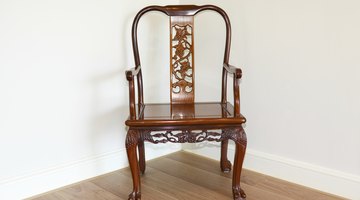How to Look After Rosewood Furniture
Known for its remarkable coloration and density, rosewood has become synonymous with luxury furniture. The high demand for rosewood species such as Brazilian and Madagascar Rosewood has threatened the trees with extinction, leading to strict trade regulations and higher prices for rosewood in general.

The rarity of rosewood makes proper care an important factor, especially in older furniture made from lumber, which can no longer be exported from its point of origin in any form.
Environmental Factors
A hardwood that grows in subtropical climates in different areas of the world, rosewood is sensitive to the surrounding environment. Rosewood furniture expands and contracts when humidity levels change. Well-made rosewood furniture contains tongue and groove joinery that allows for the natural movement of the wood without compromising the finish or durability of the furniture. If it was not properly kiln-dried before manufacturing, it may have a rippled appearance in its finish, caused by shrinkage during humidity changes. Check the furniture's finish before purchasing to ensure a smooth, mirror-like appearance. Indian rosewood, also known as Sheesham wood, has distinctive irregularities in the grain that make it more susceptible to movement with humidity and seasonal changes.
Storage and Placement
Do not store rosewood furniture in basements, which have high humidity or attics with excessive heat. Do not place rosewood furniture next to direct heat sources such as radiators, fireplaces, heaters or wood stoves, as excessive heat and dryness can cause the wood to split and crack. Avoid prolonged exposure to direct sunlight, which can fade its beautiful colors. Periodically move accessories placed on the surface of rosewood furniture to prevent dark spots from forming underneath.
Keep It Clean
Rosewood is commonly finished with lacquer, which produces a high-gloss sheen and helps protect the wood from heat and moisture. Remove dust with a soft, dry cloth or a lightly dampened cloth followed by a dry cloth to remove any moisture left behind. Although lacquer is moisture resistant, blot liquid spills up immediately with paper towels or a clean cloth to avoid damaging the finish. Set coasters under drinks to prevent moisture rings from cold drinks or heat transference from hot drinks, as excessive heat can also damage the finish. Avoid multipurpose and silicone-based cleaners.
Restoring and Refurbishing
Apply oil to your rosewood furniture once or twice a year to gently restore it to its like-new appearance. Pour a small amount of furniture oil on a soft, clean cloth and rub it over the surface of the furniture working with the grain of the wood. If too much oil is used, it adds a greasy film to the surface, so use care when applying it. Add oil to rosewood furniture in the spring and fall, when the home’s humidity is most likely to change. Only apply oil to soft-finished rosewood and not to furniture with hard finishes such as lacquer.
The Drip Cap
- Known for its remarkable coloration and density, rosewood has become synonymous with luxury furniture.
- The rarity of rosewood makes proper care an important factor, especially in older furniture made from lumber, which can no longer be exported from its point of origin in any form.
- Set coasters under drinks to prevent moisture rings from cold drinks or heat transference from hot drinks, as excessive heat can also damage the finish.
- Avoid multipurpose and silicone-based cleaners.
- Add oil to rosewood furniture in the spring and fall, when the home’s humidity is most likely to change.
References
Resources
Writer Bio
Michelle Radcliff owned a retail home furnishings business for eight years. Radcliff offers decorating advice on her blog, Home Decorating News, is a regular contributor on interior design at LoveToKnow.com and earned certification as an interior decorator from Penn Foster College in 2013.
Photo Credits
- dcylai/iStock/Getty Images
- dcylai/iStock/Getty Images
More Articles



